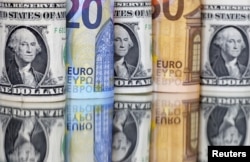Iran and Russia, both under a raft of sanctions that block their access to Western financing, are commonly vocal about the idea of the “de-dollarized” global financial system.
That idea was high on the agenda at the 51st summit of the Asian Clearing Union, a nine-member group of central banks, Iran said.
“Vice-President of the Islamic Republic [Mohammad Mokhber] says dollar domination is on the verge of collapse, noting that de-dollarization is an inevitable response of countries to the weaponization project of the dollar,” the Islamic Republic Press Agency reported from the summit in Tehran on May 24.
That is false.
There are no indications of the U.S. dollar’s imminent demise. While yielding some positions to currencies’ diversification, the greenback remains strong and continues to dominate global trade and finance.
True, the U.S. dollar’s share in global foreign exchange reserves declined from 71% in 1999 — the year the euro was launched — to 58% in the fourth quarter of 2022.
But the dollar’s share of foreign exchange reserves still greatly outstrips the second largest reserve currency, the euro, at just over 20%. The Chinese yuan or renminbi comes in at 2.7%.
Eurizon SLJ Asset Management reported in April that the sanctions the U.S. and its allies imposed on Russia for invading Ukraine have made central banks less willing to hold dollars.
Yet, Eurizon said, “the dollar will likely continue to enjoy dominance as an international currency for a while longer.”
Dan Katz, a former senior adviser at the U.S. Treasury Department, has even argued that U.S. sanctions “are a key pillar of, not a threat to, dollar dominance.”
“Sanctions strengthen the credibility of the commitment not to confiscate private investors’ assets, engendering more confidence, more global capital flows, and more secure reserve status for the dollar,” Katz wrote.
In a New York Times op-ed published in May, Nobel Prize winning economist Paul Krugman argued against claims that “the dollar’s dominance is in imminent danger.” He said such a scenario was partially being drummed up by “Putin sympathizers” seeking to punish the United States for “weaponizing” the dollar to punish Russia for its Ukraine invasion.
Krugman cited a July 2021 paper co-authored by Gita Gopinath, a top International Monetary Fund official, and Harvard economist Jeremy Stein, which outlined key areas where the U.S. dollar remains dominant.
The economists wrote that “an overwhelming fraction of international trade is invoiced and settled in dollars,” while “the dollar’s share in invoicing is far out of proportion to the U.S. economy’s role as an exporter or importer of traded goods.”
“Non-U.S. banks raise very large amounts of dollar-denominated deposits. Indeed, the dollar liabilities of non-U.S. banks, which are on the order of $10 trillion, are roughly comparable in magnitude to those of U.S. banks,” Gopinath and Stein wrote.
They argued that the dollar’s dominance “is likely to be quite resilient in the medium run.”
Brad McMillan, chief investment officer at the Commonwealth Financial Network, a privately held U.S. independent broker/dealer, also argued that the dollar’s collapse “can’t happen in the short to medium term.”
“As long as the U.S. is the largest open trading economy, as long as everyone in the world wants access to the U.S. economy, and as long as it is a lot of work and a great inconvenience to switch, the position of the dollar as the global reserve currency is secure,” McMillan wrote.
Christopher Baxter, a senior investment strategist and executive director of Morgan Stanley Wealth Management, recently wrote that the prospects of de-dollarization “seem exaggerated,” and that “the U.S. dollar’s incumbent role in the global economy is unlikely to be seriously challenged any time soon.”
The dollar remains the world’s dominant means of buying and selling goods, and is the primary unit of account, he wrote, “meaning it serves as the standard way that trading partners measure the market value of goods and services being exchanged.”
Baxter noted that foreign banks hold the largest portions of their foreign reserves in U.S. dollars, adding that there is no viable alternative to it.
On May 25, analysts at Moody’s Investor Service predicted that the “U.S. dollar's dominance in international trade and finance will persist for decades,” also noting a lack of viable alternatives.
Other financial analysts concur.
That does not mean the dollar will remain dominant forever.
The International Monetary Fund working paper published in March 2022 argued that while its collapse is not imminent, the dollar’s dominance is experiencing a “stealth erosion.”
It said the “the shift out of dollars has been in two directions: a quarter into the Chinese renminbi, and three quarters into the currencies of smaller countries that have played a more limited role as reserve currencies.”
Still, the IMF paper framed the potential end of the dollar’s dominance as “a scenario, not a prediction.”
In April, Fitch Solutions, which provides research for the Fitch Ratings credit rating agency, similarly predicted a “slow erosion” of the dollar’s dominance, but not a “paradigm shift,” likewise surmising there is no real alternative to the dollar.






